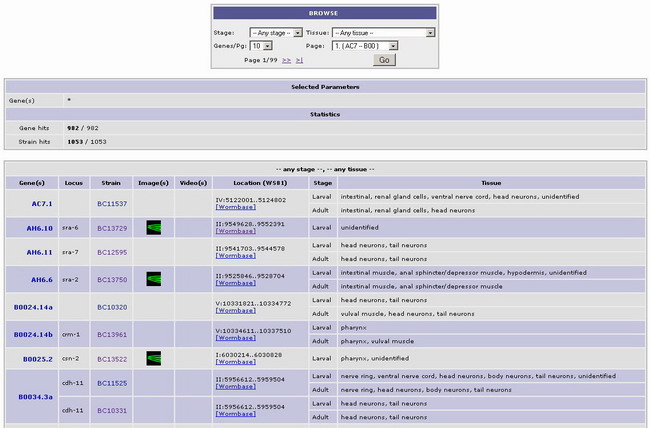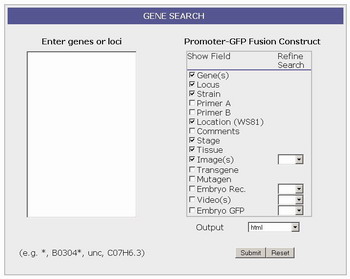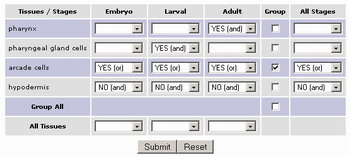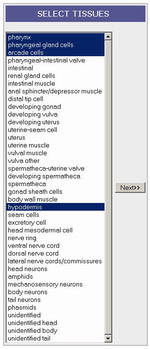|
Provided here is a database of expression patterns of C. elegans
promoter::GFP constructs. A text description of the observed pattern
is provided, indicating the stage(s) and tissue(s) in which GFP is expressed.
Also available for some strains are the corresponding 2D and 3D images.
Investigators may browse the entire list,
search by gene name, tissue, stage, and pattern. Search results may
be downloaded in .csv and .txt formats.
|
All of the strains in the expression pattern database are displayed in the browse page.
The records are organized by gene; information such as locus name, genomic
location (WormBase), the presence of images and videos, and the actual expression
pattern are shown in a tabular format.

|
|
The browse bar enables the user to filter the strains by the stages and tissues in
which they express GFP. One may also select the number of genes displayed per page, or to navigate
to the desired set of genes.
|

|
|
The result bar shows the currently selected parameters (* for all genes/strains),
the number of gene hits, strain hits, and total genes and strains in the database.
|

|
Display Options:
|
-
Stage:
Select strains which express GFP in at least one tissue, at any stage of development.
-
Tissue:
Select strains which express GFP in the tissue of choice. The strains
may not express exclusively in the selected tissue.
-
Genes/Pg:
Select the number of genes that are displayed on each page.
-
Page:
Navigate alphabetically through gene names, to a desired page.
|
The "Gene Search" page enables a user to search for one, or a set of,
promoter::GFP constructs by the cosmid or locus gene name. The search
may be refined by a number of parameters such as the availability of images, videos,
or whether expression of GFP is observed in the embryo.
|
Search Options:
|
-
A list of genes may be copied and pasted into
the "Enter genes or loci" box. Also, partial gene names and wildcards(*) may be used.
|
-
Show Field:
Select the appropriate check boxes to select the fields that are to be displayed
in the Results page or text file. See descriptions below.
-
Refine Search:
Limit the search results based on restrictions specified for the corresponding fields.
For example, checking the "Images" box and choosing "Yes" from the corresponding pull-down menu will display
only those strains for which images are available.
|

|
Description of Fields to display in the Search result
|
-
Gene(s):
The gene's cosmid name.
-
Locus:
The gene's locus name.
-
Strain:
The strain name. BC***** strains may be unstable, and have not been outcrossed.
To see if a strain is stable, refer to the transgenic name.
DM***** strains are BC strains that are stable, and have now been
outcrossed once. These strains are used for the 4D embryo recordings.
-
Primer A/B:
The primer sequences flanking the promoter region of interest. The A primer
is at the 5' end, and the B primer is at the 3' end. The B primer does
not show the GFP linker sequence "ATG CGA CCT GCA GGC ATG CAA GCT" used
in the PCR stitching technique.
-
Location:
The genomic location of the promoter region targeted for amplification.
The coordinates given are relative to the current (or displayed) WormBase version,
and shown in the format [Chr:Start..End], e.g.
[IV:5122001..5124802].
-
Comments:
Strain-specific comments.
-
Stage:
The C. elegans developmental stage in which the GFP is observed. One
of either embryo, larval, or adult.
-
Tissue:
Lists the tissue(s) expressing GFP, and triages the location of
unidentified cells/tissues (e.g. head, body, tail).
-
Image(s):
Displays a link to strain images, if available for viewing. In the text
file output, the names of the available images are reported.
-
Transgene:
The transgenic name of the strain. sEx***** indicates an unstable strain,
sIs***** indicates a stable strain, and raIs***** indicates a stable, integrated
strain that has been outcrossed.
-
Mutagen:
The mutagen used to induce integration of the extrachromosomal array into
a chromosome. However, strains exposed to a mutagen are not always
successfully integrated. See the trangenic name.
-
Embryo Rec.:
Indicates the existence of 4D embryo GFP recording. (Embryo development is
recorded for ~7 hours, collecting Nomarski image-stacks every 30 sec, with 3-5
GFP exposures interspersed over the time course.)
-
Video(s):
Displays a link to 3D movies, available for viewing in Quicktime format.
In the text file output, the names of the movies are reported.
-
Embryo GFP:
Indicates expression of GFP at any stage of embryonic development before hatching.
|
The "Pattern Search" allows the investigator to find strains which express GFP with
a specified "pattern." The pattern search first requires the selection of one or more
tissues of interest (Figure 1).
Clicking "Next" will bring you to a page that allows you to specify the
expression pattern you are searching for (Figure 2).
The selection boxes are organized in a grid, each cell representing a tissue/stage combination.
There are four options that specify whether the pattern should include (YES) or exclude (NO)
a particular tissue/stage combination.
 Figure 2
Figure 2
|
 Figure 1
Figure 1
|
| Parameters and Options: |
-
YES(and):
The selected stage/tissue combination must be present in the strain.
This is equivalent to logical AND in that all of the combos that
are assigned this option must be found in the expression pattern for it
to be returned.
-
YES(or):
The selected stage/tissue combination may be present in the strain.
This is equivalent to logical OR in that any of the combos that
are assigned this option and are found in the strain's pattern will satisfy the
OR condition.
-
NO(and):
The selected stage/tissue combination must not be present in the strain.
This is equivalent to logical NOT in that none of the combos that
are assigned this option may be found in the expression pattern for it
to be returned.
-
NO(or):
The selected stage/tissue combination may not be present in the strain.
This is equivalent to logical NOR in that any of the combos that
are assigned this option and are not found in the strain's pattern will satisfy the
condition.
-
Group:
This option is meant to group a set of conditions for a particular tissue across the
range of stages. For example, if one wants to find a strain with expression of GFP
in arcade cells at any stage (YES(or) in all stages) and also specify some OR conditions
in another tissue.
-
Group All:
Aggregate all of the OR conditions (AND conditions are naturally aggregate).
-
All Stages:
A convenient switch to set all stages within a given tissue to the desired condition.
-
All Tissues:
A convenient switch to set all the tissues within a given stage to the desired condition.
|
|